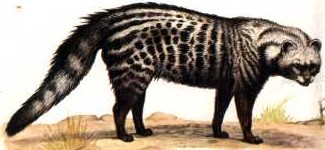To next page
Cowar el-aqalim (1347) written in Kirkman-Perzia
----------------------------------------------
Taken from: Cl. Huart: XIV congres int. des Orientalistes
This geography was written by an unknown author for the prince Mobariz-eddin Mohammad, son of Mozaffer

After this region is the region of (the mountains) of the moon; these are several towns and places which are called Dendeme and Kirichne. On the shores of the Ocean is a mountain which stretches towards the east, up to the middle of the land of Sofala, as far as 1,400 parasanges. Several kinds of animals and plants are found in the mountain, as well as rivers who in big numbers reach the sea in the inhabited quarter of the world. The mountains of the moon are to the west of this mountain; several rivers leave there big and deep ones, they are called the Nile of Egypt. These waters make two big lakes measuring 100 parasanges by 100. To the west of those lakes one sees a big mountain and a region which is called Refle. The Nil goes through those lakes and continues. The equator meets the river in a western direction; it goes on for 350 parasanges, several branches of the Nile water, which is sweet, meet the salty water of the Ocean, leaving the ocean again without mixing; the river reaches Mehir, Alexandria and the sea of the Francs. This passage of the Qoran: He has separated the two seas that touched, he has put up a barrier between them, of fear that they wouldn't mix. Of this the theologians don't know exactly what God wanted to explain with those two seas. (the sea and the river).
After this he talks a lot about several animals of east Africa.
The Nile, from the mountains of the moon from which he leaves up to the place where it throws itself into the sea of the Francs, measures close to 1000 parasanges.